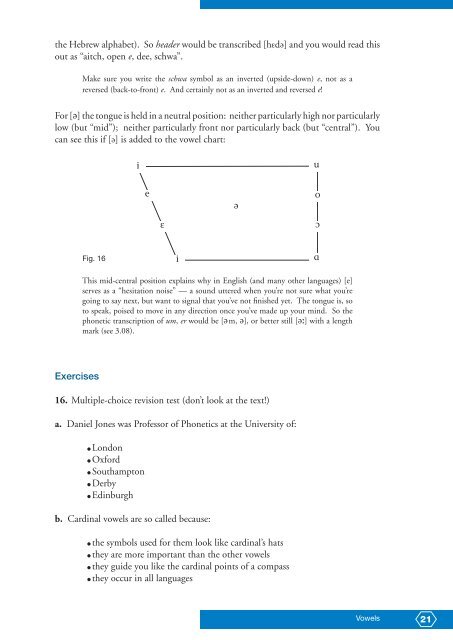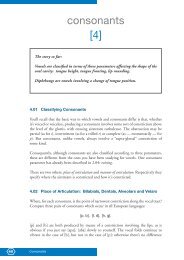PHONETICS MANUAL.indd - HumBox
PHONETICS MANUAL.indd - HumBox
PHONETICS MANUAL.indd - HumBox
Create successful ePaper yourself
Turn your PDF publications into a flip-book with our unique Google optimized e-Paper software.
the Hebrew alphabet). So header would be transcribed [hEd@] and you would read this<br />
out as “aitch, open e, dee, schwa”.<br />
Make sure you write the schwa symbol as an inverted (upside-down) e, not as a<br />
reversed (back-to-front) e. And certainly not as an inverted and reversed e!<br />
For [@] the tongue is held in a neutral position: neither particularly high nor particularly<br />
low (but “mid”); neither particularly front nor particularly back (but “central”). You<br />
can see this if [@] is added to the vowel chart:<br />
i<br />
u<br />
e<br />
@<br />
o<br />
E<br />
O<br />
Fig. 16<br />
i<br />
A<br />
This mid-central position explains why in English (and many other languages) [e]<br />
serves as a “hesitation noise” — a sound uttered when you’re not sure what you’re<br />
going to say next, but want to signal that you’ve not finished yet. The tongue is, so<br />
to speak, poised to move in any direction once you’ve made up your mind. So the<br />
phonetic transcription of um, er would be [@m, @], or better still [@:] with a length<br />
mark (see 3.08).<br />
Exercises<br />
16. Multiple-choice revision test (don’t look at the text!)<br />
a. Daniel Jones was Professor of Phonetics at the University of:<br />
London<br />
Oxford<br />
Southampton<br />
Derby<br />
Edinburgh<br />
b. Cardinal vowels are so called because:<br />
the symbols used for them look like cardinal’s hats<br />
they are more important than the other vowels<br />
they guide you like the cardinal points of a compass<br />
they occur in all languages<br />
Vowels<br />
21






